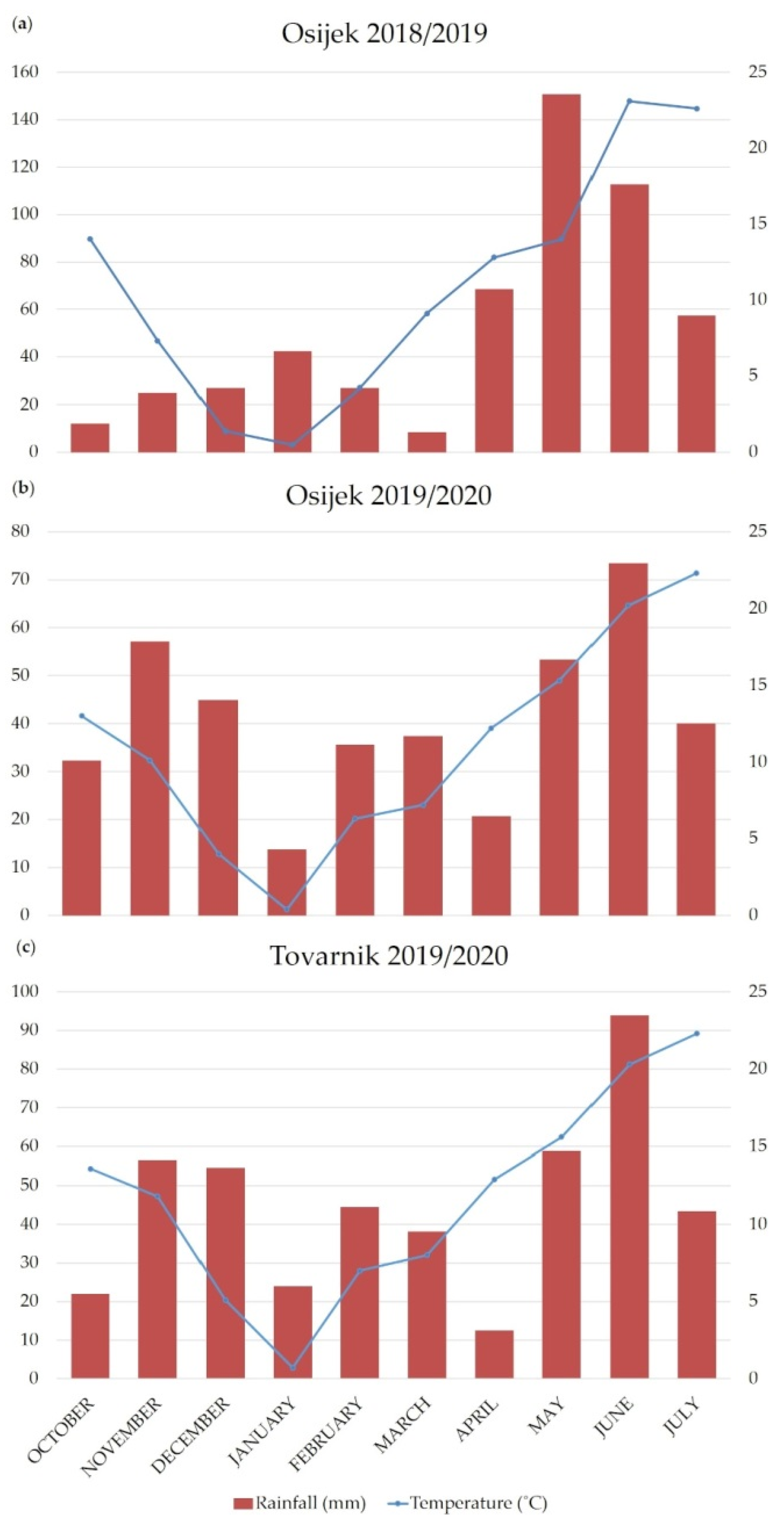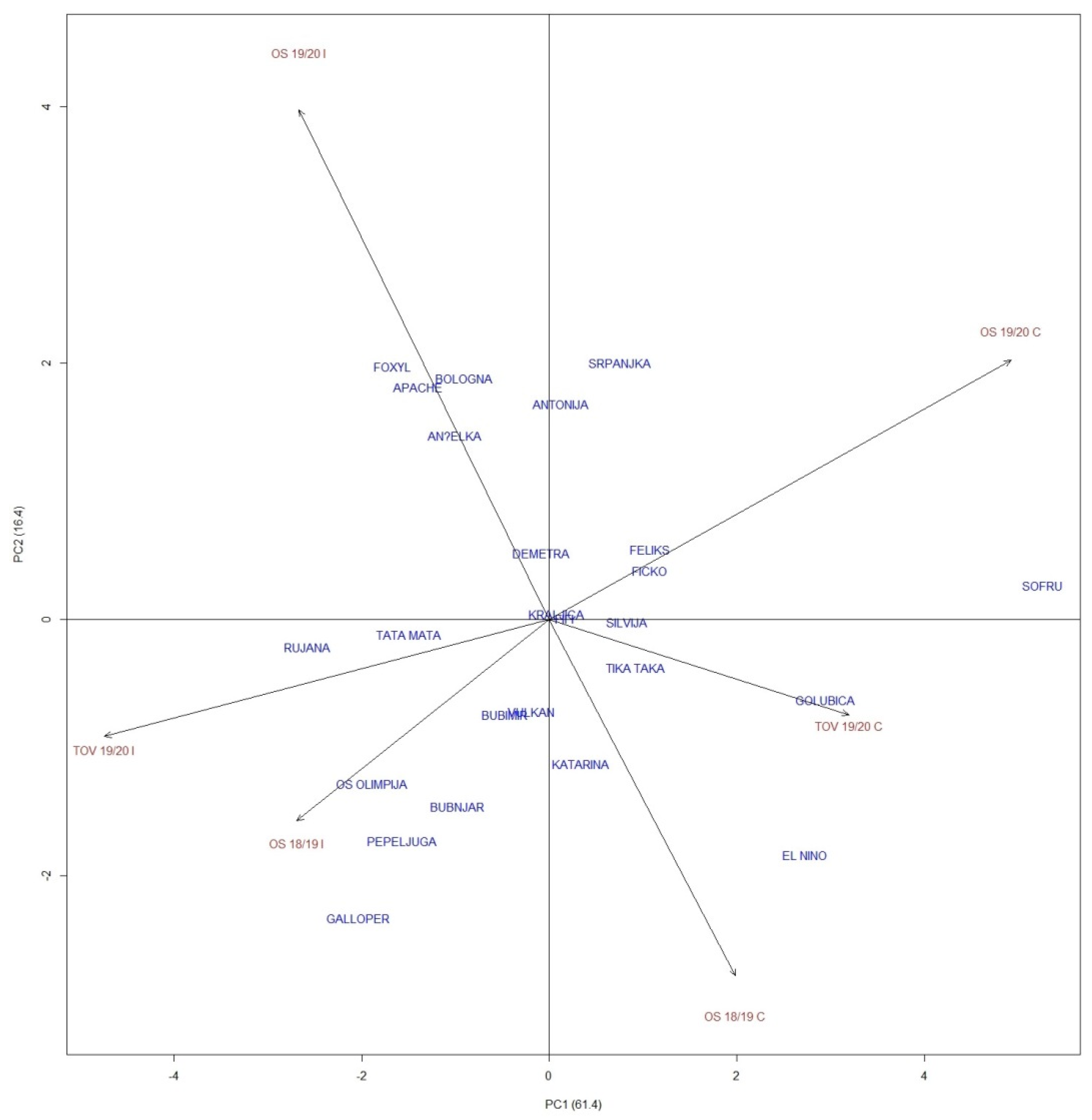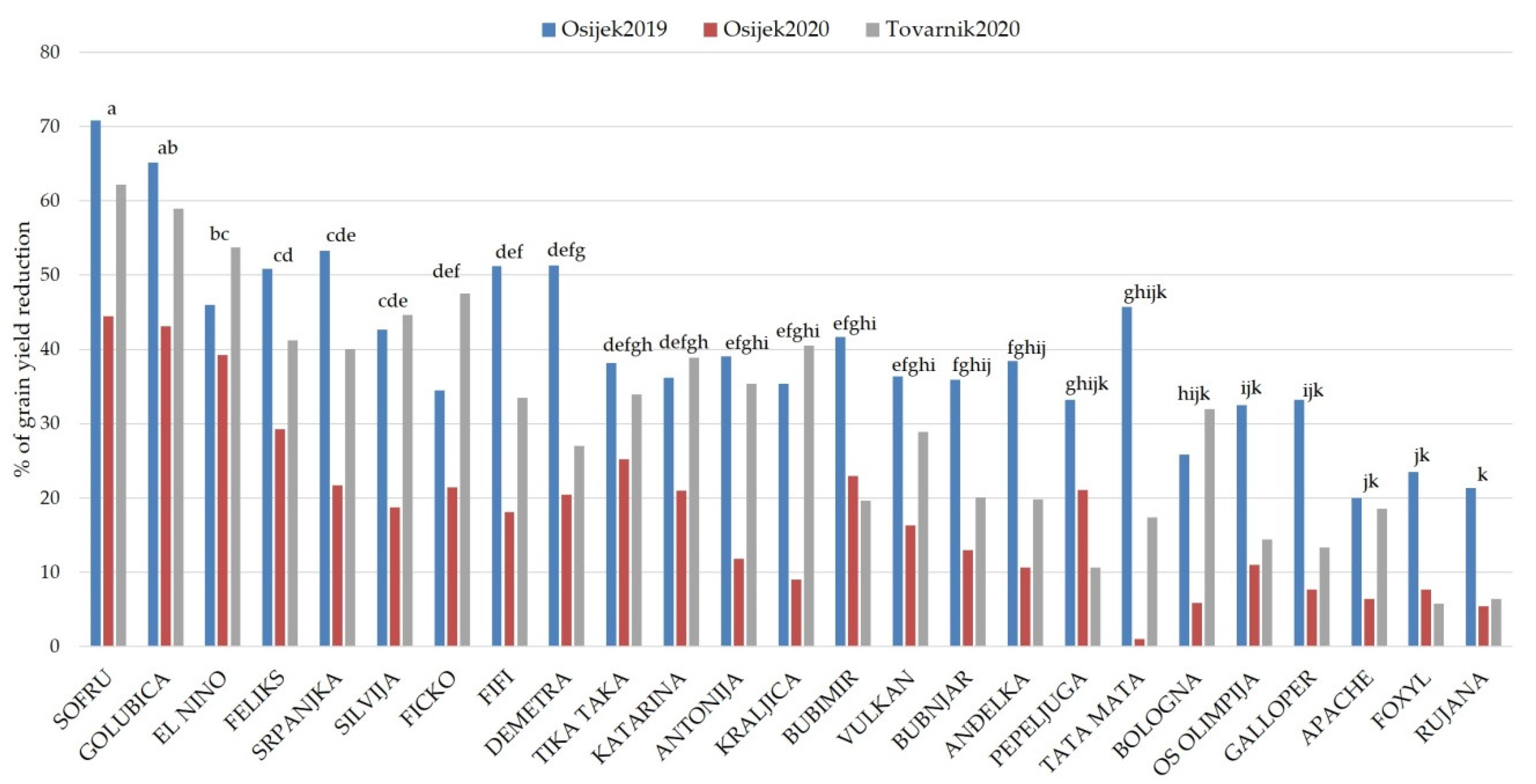Characterization of Agronomical and Quality Traits of Winter Wheat (Triticum aestivum L.) for Fusarium Head Blight Pressure in Different Environments
Abstract
1. Introduction
2. Materials and Methods
2.1. Field Experiments
2.2. Fusarium Inoculum Production, Inoculation Procedure and Disease Assessment
2.3. Statistical Analysis
3. Results
3.1. Fusarium Head Blight (FHB) Scoring in Fusarium Artificially Inoculated Treatment
3.2. Stability of Wheat Grain Yield in Six Environmental Conditions
3.3. Relation among Important Agronomical and Quality Traits in Six Environments
3.4. Imapct of FHB Inoculation on Investigated Traits in Relation to Natural Infection Treatment
4. Discussion
4.1. Grain Yield Stability of Winter Wheat Varieties under Increased FHB Pressure and Natural Disease Infection
4.2. Principal Component Analysis for Nine Agronomical and Quality Traits in Six Different Environmental Conditions
4.3. High FHB Pressure Impact on Quality Traits
5. Conclusions
Supplementary Materials
Author Contributions
Funding
Institutional Review Board Statement
Informed Consent Statement
Data Availability Statement
Acknowledgments
Conflicts of Interest
References
- Siddiqui, K. Green biotechnology at the crossroads of nanobiotechnology, globalization, poverty alleviation and food sovereignty. Indian J. Crop Sci. 2007, 2, 1–5. [Google Scholar]
- Shewry, P.R.; Hey, S.J. The contribution of wheat to human diet and health. Food Energy Secur. 2015, 4, 178–202. [Google Scholar] [CrossRef] [PubMed]
- Curtis, B.C. Wheat in the World. Bread Wheat: Improvement and Production; FAO (Food and Agriculture Organization of the United Nations), Plant Production and Protection: Rome, Italy, 2002. [Google Scholar]
- Oerke, E.C.; Steiner, U.; Dehne, H.W.; Lindenthal, M. Thermal imaging of cucumber leaves affected by downy mildew and environmental conditions. J. Exp. Bot. 2006, 57, 2121–2132. [Google Scholar] [CrossRef] [PubMed]
- Tesfay, B.; Araya, A. Grain and biomass yield reduction due to Russian wheat aphid on bread wheat in northern Ethiopia. Afr. Crop Sci. J. 2015, 23, 197–202. [Google Scholar]
- Nuttall, G.; O’Leary, G.J.; Panozzo, J.F.; Walker, C.K.; Barlow, K.M.; Fitzgerald, G.J. Models of grain quality in wheat—A review. Field Crops Res. 2017, 202, 136–145. [Google Scholar] [CrossRef]
- Kosina, P.; Reynolds, M.; Dixon, J.; Joshi, A. Stakeholder perception of wheat production constraints, capacity building needs, and research partnerships in developing countries. Euphytica 2007, 157, 475–483. [Google Scholar] [CrossRef]
- Leslie, J.F.; Summerell, B.A. The Fusarium Laboratory Manual, 1st ed.; Blackwell Publishing: Ames, IA, USA, 2006. [Google Scholar]
- Figueroa, M.; Hammond-Kosack, K.E.; Solomon, P.S. A review of wheat diseases-a field perspective. Mol. Plant Pathol. 2018, 19, 1523–1536. [Google Scholar] [CrossRef]
- Mishra, S.; Srivastava, S.; Dewangan, J.; Divakar, A.; Kumar Rath, S. Global occurrence of deoxynivalenol in food commodities and exposure risk assessment in humans in the last decade: A survey. Crit. Rev. Food Sci. Nutr. 2019, 60, 1346–1374. [Google Scholar] [CrossRef]
- Iwanska, M.; Jakub Paderewski, J.; Stepien, M.; Rodrigues, P.C. Adaptation of Winter Wheat Cultivars to Different Environments: A Case Study in Poland. Agronomy 2020, 10, 632. [Google Scholar] [CrossRef]
- Huang, M.; Cabrera, A.; Hoffstetter, A.; Griffey, C.; Van Sanford, D.; Costa, J.; McKendry, A.; Chao, S.; Sneller, C. Genomic selection for wheat traits and trait stability. Theor. Appl. Genet. 2016, 129, 1697–1710. [Google Scholar] [CrossRef]
- Lozada, D.N.; Mason, R.E.; Babar, M.A.; Carver, B.F.; Guedira, G.B.; Merrill, K.; Arguello, M.N.; Acuna, A.; Vieira, L.; Holder, A.; et al. Association mapping reveals loci associated with multiple traits that affect grain yield and adaptation in soft winter wheat. Euphytica 2017, 213, 222. [Google Scholar] [CrossRef]
- Madden, L.V.; Paul, P.A.; Lipps, P.E. Consideration of nonparametric approaches for assessing genotype-byenvironment (G×E) interaction with disease severity data. Plant Dis. 2007, 91, 891–900. [Google Scholar] [CrossRef] [PubMed]
- Anandan, A.; Sabesan, T.; Eswaran, R.; Rajiv, G.; Muthalagan, N.; Suresh, R. Appraisal of Environmental Interaction on Quality Traits of Rice by Additive Main Effects and Multiplicative Interaction Analysis. Cereal Res. Commun. 2009, 37, 131–140. [Google Scholar] [CrossRef]
- Rymuza, K.; Turska, E.; Wielogórska, G.; Bombik, A. Use of principal component analysis for the assessment of spring wheat characteristics. Acta Sci. Pol. Agric. 2012, 11, 79–90. [Google Scholar]
- Priya, B.; Das, B.; Satyanarayana, N.H.; Mukherjee, S.; Sarkar, K.K. Genetic diversity of wheat genotypes based on principal component analysis in Gangetic alluvial soil of West Bengal. J. Crop Weed 2014, 10, 104–107. [Google Scholar]
- Lemmens, M.; Haim, K.; Lew, H.; Ruckenbauer, P. The effect of nitrogen fertilization on Fusarium head blight development and deoxynivalenol contamination in wheat. Phytopathology 2004, 152, 1–8. [Google Scholar] [CrossRef]
- Zadoks, J.C.; Chang, T.T.; Konzac, F.C. A decimal code for the growth stages of cereals. Weed Res. 1974, 14, 415–421. [Google Scholar] [CrossRef]
- Shaner, G.; Finney, R.A. The effect of nitrogen fertilization on the expression of slow-mildewing resistance in Knox wheat. Phytopathology 1977, 67, 1051–1056. [Google Scholar] [CrossRef]
- R Core Team. R: A Language and Environment for Statistical Computing; R Foundation for Statistical Computing: Vienna, Austria, 2020; Available online: http://www.R-project.org (accessed on 15 September 2020).
- De Mendiburu, F. Agricolae: Statistical Procedures for Agricultural Research. R Package Version 1.3-3. 2020. Available online: https://CRAN.R-project.org/package=agricolae (accessed on 15 September 2020).
- Vu, V.Q. Ggbiplot: A Ggplot2 Based Biplot. R Package Version 0.55. 2011. Available online: http://github.com/vqv/ggbiplot (accessed on 15 September 2020).
- Lollato, R.P.; Edwards, J.T. Maximum attainable wheat yield and resource-use efficiency in the southern Great Plains. Crop Sci. 2015, 55, 2863–2876. [Google Scholar] [CrossRef]
- Drezner, G.; Dvojkovic, K.; Horvat, D.; Novoselovic, D.; Lalic, A. Environmental impacts on wheat agronomic and quality traits. Cereal Res. Commun. 2007, 35, 357–360. [Google Scholar] [CrossRef]
- Yan, W.; Kang, M.S. GGE Biplot Analysis: A Graphical Tool for Breeders, Geneticists, and Agronomists; CRC Press: Boca Raton, FL, USA, 2002. [Google Scholar]
- Iwata, H.; Nesumi, H.; Ninomiya, S.; Takano, Y.; Ukai, Y. The evaluation of genotype × environment interactions of citrus leaf morphology using image analysis and elliptic fourier descriptors. Breed. Sci. 2002, 52, 243–251. [Google Scholar] [CrossRef]
- Lin, C.S.; Binns, M.R. Concepts and methods for analyzing regional trial data for cultivar and location selection. Plant Breed. Rev. 1994, 12, 271–297. [Google Scholar] [CrossRef]
- Cooper, M.; Woodruff, D.R.; Eisemann, R.L.; Brennan, P.S.; DeLacy, I.H. A selection strategy to accommodate genotype-by-environment interaction for grain yieldseed yield of wheat: Managed-environments for selection among genotypes. Theor. Appl. Genet. 1995, 90, 492–502. [Google Scholar] [CrossRef] [PubMed]
- Yau, S.K. Regression and AMMI analyses of genotype × environment interactions: An empirical comparison. Agron. J. 1995, 87, 121–126. [Google Scholar] [CrossRef]
- Spanic, V.; Lemmens, M.; Drezner, G. Variability of components of Fusarium head blight resistance among wheat genotypes. Cereal Res. Commun. 2013, 41, 420–430. [Google Scholar] [CrossRef]
- Martinčić, J.; Kozumplik, V. Oplemenjivanje Bilja: Teorije i Metode, Ratarske Culture; Poljoprivredni Fakultet Osijek i Agronomski Fakultet Zagreb: Zagreb, Hrvatska, 1996. [Google Scholar]
- Trethowan, R.; Crossa, J. Lessons learnt from forty years of international spring bread wheat trials. Euphytica 2007, 157, 385–390. [Google Scholar] [CrossRef]
- Ceccarelli, S. Positive interpretation of genotype by environment interaction in relation to sustainability and biodiversity. In Plant Adaptation and Crop Improvement; Cooper, M., Hammer, G.L., Eds.; CAB International: Wallingford, UK, 1996; pp. 467–486. [Google Scholar]
- Rodriguez, M.; Rau, D.; Papa, R.; Attene, G. Genotype by environment interactions in barley (Hordeum vulgare L.): Different responses of landraces, recombinant inbred lines and varieties to Mediterranean environment. Euphytica 2008, 163, 231–247. [Google Scholar] [CrossRef]
- Sandhu, P.S.; Brar, K.S.; Chauhan, J.S.; Meena, P.D.; Awasthi, R.P.; Rathi, A.S.; Kumar, A.; Gupta, J.C.; Kolte, S.J.; Manhas, S.S. Host–pathogen interactions of Brassica genotypes for white rust (Albugo candida) disease severity under aided epiphytotic conditions in India. Phytoparasitica 2015, 43, 197–207. [Google Scholar] [CrossRef]
- Khodadadi, M.; Fotokian, M.H.; Miransari, M. Genetic diversity of wheat (Triticum aestivum L.) genotypes based on cluster and principal component analyses for breeding strategies. Aust. J. Crop Sci. 2011, 5, 17. [Google Scholar]
- Dotlačil, L.; Hermuth, J.; Stehno, Z.; Manev, M. Diversity in European winter wheat landraces and obsolete cultivars. Czech J. Genet. Plant Breed. 2000, 36, 29–36. [Google Scholar]
- Samar, P.V.; Pathak, V.N.; Verma, O.P. Interrelationship between yield and its contributing traits in wheat (Triticum aestivum L.). Int. J. Curr. Microbiol. Appl. Sci. 2019, 8, 3209–3215. [Google Scholar] [CrossRef]
- Deyong, Z. Analysis among main agronomic traits of spring wheat (Triticum aestivum) in Qinghai Tibet plateau. Bulg. J. Agric. Sci. 2011, 17, 615–622. [Google Scholar]
- Protić, R.; Todorović, G.; Protić, N. Correlations of yield and grain yield components of winter wheat varieties. J. Agric. Sci. (Belgrade) 2009, 54, 213–221. [Google Scholar] [CrossRef]
- Schuler, S.F.; Bacon, R.K.; Finney, E.L.; Gbur, E.E. Relationship of test weight and kernel properties to milling and baking quality in soft red winter wheat. Crop Sci. 1995, 35, 949–953. [Google Scholar] [CrossRef]
- Saint Pierre, C.; Peterson, J.; Ross, A.; Ohm, J.B.; Verhoeven, M.; Larson, M.; Hoefer, B. White wheat grain quality changes with genotype, nitrogen fertilization, and water stress. Agron. J. 2008, 100, 414–420. [Google Scholar] [CrossRef]
- Jablonskytė-Raščė, D.; Maikštėnienė, S.; Mankevičienė, A. Evaluation of productivity and quality of common wheat (Triticum aestivum L.) and spelt (Triticum spelta L.) in relation to nutrition conditions. Zemdirbyste Agric. 2013, 100, 45–56. [Google Scholar] [CrossRef]
- Trethowan, R.M.; Reynolds, M.P.; Ortiz-Monasterio, J.I.; Ortiz, R. The genetic basis of the green revolution in wheat production. Plant Breed. Rev. 2007, 28, 39–58. [Google Scholar] [CrossRef]
- Finlay, G.J.; Bullock, P.R.; Sapirstein, H.D.; Naeem, H.A.; Hussain, A.; Angadi, S.V.; Depauw, R.M. Genotypic and environmental variation in grain, flour, dough and bread-making characteristics of western Canadian spring wheat. Can. J. Plant Sci. 2007, 87, 679–690. [Google Scholar] [CrossRef]
- Dupont, F.M.; Altenbach, S.B. Molecular and biochemical impacts of environmental factors on wheat grain development and protein synthesis. J. Cereal Sci. 2003, 38, 133–146. [Google Scholar] [CrossRef]
- Grausgruber, H.; Oberforster, M.; Werteker, M.; Ruckenbauer, P.; Vollmann, J. Stability of quality in Austrian-grown winter wheats. Field Crops Res. 2000, 66, 257–267. [Google Scholar] [CrossRef]
- Mellado, M. El trigo en Chile. Colección de Libros INIA N°21; Instituto de Investigaciones Agropecuarias INIA, Centro Regional de Investigación Quilamapu: Chillán, Chile, 2007. [Google Scholar]
- Pawelzik, E.; Permady, H.; Weinert, J.; Wolf, G.A. Effect of Fusarium-contamination on selected quality criteria of wheat. Getreide Mehl Brot 1998, 52, 264–266. [Google Scholar]
- Matthäus, K.; Dänicke, S.; Vahjen, W.; Simon, O.; Wang, J.; Valenta, H.; Meyer, K.; Strumpf, A.; Ziesenib, H.; Flachowsky, G. Progrssion of mycotoxin and nutrient concentrations in wheat after inoculation with Fusarium culmorum. Arch. Anim. Nutr. 2002, 58, 19–35. [Google Scholar] [CrossRef] [PubMed]
- Branlard, G.; Dardevet, M.; Saccomano, R.; Lagoutte, F.; Gourdon, J. Genetic diversity of wheat storage proteins and bread wheat quality. Euphytica 2001, 119, 59–67. [Google Scholar] [CrossRef]




| AUDPC | |||
|---|---|---|---|
| Varieties | Osijek 2018/19 | Osijek 2019/20 | Tovarnik 2019/20 |
| FELIKS | 392 | 203 | 455 |
| DEMETRA | 369 | 92 | 150 |
| SRPANJKA | 362 | 250 | 291 |
| KATARINA | 348 | 83 | 158 |
| FIFI | 339 | 101 | 159 |
| SOFRU | 331 | 94 | 151 |
| GOLUBICA | 298 | 104 | 93 |
| BUBIMIR | 263 | 90 | 34 |
| TATA MATA | 256 | 56 | 159 |
| EL NINO | 217 | 137 | 213 |
| ANĐELKA | 216 | 67 | 76 |
| OS OLIMPIJA | 198 | 60 | 49 |
| PEPELJUGA | 189 | 53 | 14 |
| ANTONIJA | 179 | 49 | 33 |
| KRALJICA | 139 | 72 | 18 |
| TIKA TAKA | 129 | 43 | 70 |
| FICKO | 125 | 29 | 37 |
| VULKAN | 117 | 36 | 34 |
| SILVIJA | 95 | 13 | 39 |
| BUBNJAR | 62 | 10 | 19 |
| GALLOPER | 59 | 1 | 18 |
| BOLOGNA | 55 | 16 | 3 |
| FOXYL | 33 | 3 | 0.8 |
| RUJANA | 17 | 0.2 | 0.4 |
| APACHE | 17 | 7 | 1 |
| AUDPC | 91b * | 66c | 192a |
| Source of Variation | Df | MS | F-Value |
|---|---|---|---|
| Variety (G) | 24 | 860.06 | 14.68 *** |
| Environment (E) | 5 | 26,390.00 | 450.35 *** |
| G × E | 120 | 154.00 | 2.62 *** |
| Residuals | 150 | 59 |
| Traits | PC1 | PC2 | PC3 | PC4 | PC5 | PC6 | PC7 | PC8 | PC9 |
|---|---|---|---|---|---|---|---|---|---|
| *GY | 0.464 | 0.160 | 0.000 | 0.141 | 0.132 | 0.000 | 0.294 | 0.794 | 0.000 |
| TW | 0.359 | 0.456 | 0.000 | 0.103 | 0.137 | −0.110 | 0.561 | −0.552 | 0.000 |
| TKW | 0.399 | 0.344 | 0.108 | 0.000 | 0.222 | −0.335 | −0.737 | 0.000 | 0.000 |
| P | −0.414 | 0.186 | 0.146 | 0.366 | −0.158 | −0.56 | 0.000 | 0.126 | 0.523 |
| SED | 0.000 | 0.556 | −0.152 | 0.322 | −0.489 | 0.529 | −0.191 | 0.000 | 0.000 |
| VG | −0.427 | 0.359 | 0.000 | 0.000 | 0.106 | −0.303 | 0.000 | 0.165 | −0.738 |
| GI | 0.274 | 0.000 | −0.506 | −0.382 | −0.601 | −0.395 | 0.000 | 0.000 | 0.000 |
| FN | 0.000 | 0.143 | 0.778 | −0.485 | −0.368 | 0.000 | 0.000 | 0.000 | 0.000 |
| VG/P | −0.245 | 0.393 | −0.270 | −0.587 | 0.376 | 0.178 | 0.000 | 0.114 | 0.425 |
| SS loadings | 1.000 | 1.000 | 1.000 | 1.000 | 1.000 | 1.000 | 1.000 | 1.000 | 1.000 |
| SD | 1.955 | 1.377 | 1.056 | 0.909 | 0.822 | 0.622 | 0.373 | 0.360 | 0.083 |
| % of TV | 42.487 | 21.067 | 12.383 | 9.185 | 7.510 | 4.304 | 1.549 | 1.437 | 0.077 |
| Naturally Infected | Trait | ||||||||
|---|---|---|---|---|---|---|---|---|---|
| Environment | GY* | TW | 1000 KW | P | SED | VG | GI | FN | VG/P |
| Osijek 2018/2019 | 80.4 c | 78.0 c | 33.9 c | 13.2 a | 38.5 a | 28.8 a | 89.5 c | 335.2 a | 2.2 b |
| Osijek 2019/2020 | 112.5 a | 83.6 b | 44.4 a | 10.7 c | 30.9 b | 22.0 b | 98.8 a | 347.3 a | 2.0 c |
| Tovarnik 2019/2020 | 87.2 b | 85.2 a | 43.0 b | 12.8 b | 38.2 a | 29.1 a | 94.5 b | 338.5 a | 2.3 a |
| FHB Inoculated | |||||||||
| Osijek 2018/2019 | 48.4 c | 64.7 c | 26.8 c | 14.1 a | 32.8 a | 31.1 a | 86.4 a | 327.2 b | 2.2 b |
| Osijek 2019/2020 | 91.8 a | 78.2 a | 38.3 a | 12.6 b | 30.4 b | 24.9 c | 89.5 a | 370.7 a | 2.0 c |
| Tovarnik 2019/2020 | 60.2 b | 73.9 b | 32.5 b | 12.5 a | 29.1 b | 28.8 b | 88.3 a | 351.8 a | 2.3 a |
Publisher’s Note: MDPI stays neutral with regard to jurisdictional claims in published maps and institutional affiliations. |
© 2021 by the authors. Licensee MDPI, Basel, Switzerland. This article is an open access article distributed under the terms and conditions of the Creative Commons Attribution (CC BY) license (http://creativecommons.org/licenses/by/4.0/).
Share and Cite
Spanic, V.; Cosic, J.; Zdunic, Z.; Drezner, G. Characterization of Agronomical and Quality Traits of Winter Wheat (Triticum aestivum L.) for Fusarium Head Blight Pressure in Different Environments. Agronomy 2021, 11, 213. https://doi.org/10.3390/agronomy11020213
Spanic V, Cosic J, Zdunic Z, Drezner G. Characterization of Agronomical and Quality Traits of Winter Wheat (Triticum aestivum L.) for Fusarium Head Blight Pressure in Different Environments. Agronomy. 2021; 11(2):213. https://doi.org/10.3390/agronomy11020213
Chicago/Turabian StyleSpanic, Valentina, Josipa Cosic, Zvonimir Zdunic, and Georg Drezner. 2021. "Characterization of Agronomical and Quality Traits of Winter Wheat (Triticum aestivum L.) for Fusarium Head Blight Pressure in Different Environments" Agronomy 11, no. 2: 213. https://doi.org/10.3390/agronomy11020213
APA StyleSpanic, V., Cosic, J., Zdunic, Z., & Drezner, G. (2021). Characterization of Agronomical and Quality Traits of Winter Wheat (Triticum aestivum L.) for Fusarium Head Blight Pressure in Different Environments. Agronomy, 11(2), 213. https://doi.org/10.3390/agronomy11020213






